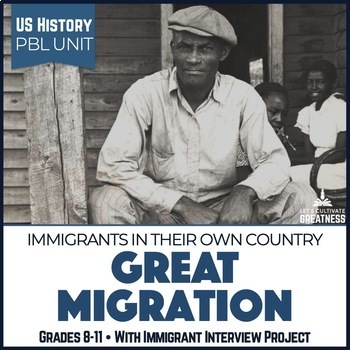US Mini PBL Unit African American Great Migration with Interview Project
- Zip
Description
Strengthen your 1920s Harlem Renaissance, WWI, WWII, or Civil Rights units with an exploration of the Great Migration experience. Read the moving poetic words of Langston Hughes, hear the narratives of three individuals who escaped oppression for a better life, and examine the massive statistics each of these 6 million American Dreamers helped create. Culminate students' learning with their own oral history interview project!
By the end of this unit, your students will be able to
- Annotate and analyze written, oral, and statistical primary sources for quantitative and qualitative evidence
- Annotate and analyze historical poetry as a primary source
- Plan, conduct, narrate, and reflect on own interview in an oral history narrative essay project
************************************
Greatness is learning to really listen and learn from others’ experiences.
America is a nation like no other, for many reasons, but perhaps most so for its perennial storyline of the one-part-hopeful, one-part-determined immigrant citizen. The brave dreamers who fled the South for better opportunities in Northern and Western cities were no different. Faceless souls who make up the swelled statistics of census data reports; poignant stories of mothers and fathers and children wanting nothing more than what we all want: self-determination. Both tell the rich and patriotic stories of the convergence of our dearest American values: hard work, opportunity, and equality.
Introduce your students to a sampling of Americans who help make up the African American migration story, guiding them truly articulate their beliefs on “What is an immigrant?"
Leave the boring chronological textbook behind and head straight to the compelling sources that make this question central to our pride and identity as Americans, and engage your students to create their own oral history!
The beauty of a thematic unit is your freedom to mix-and-match, add-and-subtract: each activity is self-contained, allowing for complete customization to meet local standards, time restraints, and interests.
This mini-unit can be done well in anywhere from 2 to 3 weeks!
Included in this mini-unit:
Teacher Materials
- Unit Overview & 4 pages of Daily Lesson Plans from the unit hook to the project assessment
- Suggested Answer Keys
- Rubrics, both CCSS-aligned and generic
- 46-slide editable PowerPoint slideshow with images, links, and student directions
Student Materials & Activities
- Concept Definition for students’ unit-long note-taking
- Contextual Overview summary of the event with a statistical graph and select photos
- Graph Analysis of various demographic maps of African American population trends
- By the Numbers statistical analysis of the Great Migration
- Warmth of Other Suns Analysis with narrative excerpts annotating and jigsaw small group discussions
- Poem Analysis of Langston Hughes's famous piece, "One Way Ticket"
- Oral History Interview supported by step-by-step planning guide, rubrics, exploring the diversity and opportunity that make up the American Dream
- 3 Skill Sheets Annotating a Text, DECODE Poem Source Analysis, Citing Evidence & Sourcing
NOTE: This mini-unit relies on excerpts from the fantastic book, The Warmth of Other Suns, by Isabel Wilkerson, easily available at your local library or for purchase on Amazon
************************************
Want just the project?
Interview Narrative Project use this universal writing project pack to make almost any unit into a PBL unit!
Want to make this into a whole unit?
What is Our American Story: Immigration & the American Dream PBL Unit explore Ellis Island, the Great Migration, and Vietnamese Americans in this complete thematic unit
Want more U.S. History PBL Units?
Six Degrees of Separation: kick off a study of our country’s geography with a “Flat Stanley” style project
1600-1800s American Values: explore the founders of America, from the Puritans to the Nez Perce, and their core values in order to develop one’s own goal and motivational plan of action for the school year
1900s Protest Movements: be inspired by Silent Sentinels to Alcatraz Occupiers to develop one’s own statement of protest or support
1900s American Heroes: explore what it means to be a hero from Madam CJ Walker to John Glenn in order to nominate one’s own hero for recognition
What to go entirely PBL?
U.S. History PBL Course Mega Bundle: get all posted PBL resources in one download and save big!
This listing is for one license for regular classroom use by a single teacher only. In upholding copyright law, resources are uneditable, unless otherwise stated. By purchasing a license to this resource, you have access to all future updates at no cost, available under “My Purchases". Multiple and transferable licenses are available for purchase. To request a complete terms of use prior to purchase or if you have any questions about this resource, please leave a question below under Product Q&A.





